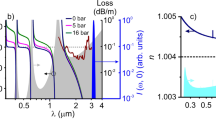Abstract
We describe the virtues of the pump–probe approach for controlled supercontinuum generation in nonlinear media, using the example of pulse compression by cross-phase modulation in dielectrics. Optimization of a strong (pump) pulse and a weak (probe) pulse at the input into the medium opens the route to effective control of the supercontinuum phases at the output. We present an approximate semi-analytical approach which describes nonlinear transformation of the input pulse into the output pulse. It shows how the input and the output chirps are connected via a time-warp transformation which is almost independent of the shape of the probe pulse. We then show how this transformation can be used to optimize the supercontinuum generation to produce nearly single-cycle pulses tunable from mid-infrared to ultraviolet.
Similar content being viewed by others
References
G.P. Agrawal: Nonlinear Fiber Optics (Academic, San Diego 1995)
R.W. Boyd: Nonlinear Optics (Academic, San Diego 1992)
Although the slowly varying envelope approximation breaks down near the single-cycle regime, previous analytical studies of relevance to the present work have used this approximation to show the potential for pulse compression by XPM. See e.g. E.M. Dianov, P.V. Mamyshev, A.M. Prokhorov, S.V. Chernikov: Kvant. Elektron. 15, 1941 (1988); A.M. Zheltikov, N.I. Koroteev, A.N. Naumov: JETP 88, 857 (1999)
C.G. Durfee III, S. Backus, H.C. Kapteyn, M.M. Murnane: Opt. Lett. 24, 697 (1999)
A.V. Sokolov, D.R. Walker, D.D. Yavuz, G.Y. Yin, S.E. Harris: Phys. Rev. Lett. 87, 033402 (2001); Phys. Rev. Lett. 85, 562 (2000)
N. Zhavoronkov, G. Korn: Phys. Rev. Lett. 88, 203901 (2002) and references therein
R.A. Bartels, T.C. Weinacht, N. Wagner, M. Baertschy, C.H. Greene, M.M. Murnane, H.C. Kapteyn: Phys. Rev. Lett. 88, 013903 (2002)
R.L. Fork, C.H. Brito Cruz, P.C. Becker, C.V. Shank: Opt. Lett. 12, 483 (1987)
A. Baltuška, Z. Wei, M.S. Pshenichnikov, D.A. Wiersma: Opt. Lett. 22, 102 (1997)
M. Nisoli, S.D. Silvestri, R. Szipocs, K. Ferencz, C. Spielmann, S. Sartania, F. Krausz: Opt. Lett. 22, 522 (1997)
A. Baltuška, T. Fuji, T. Kobayashi: Opt. Lett. 27, 306 (2002)
A.M. Weiner: Prog. Quantum Electron. 19, 161 (1995)
F. Verluise, V. Laude, Z. Cheng, C. Spielmann, P. Tournois: Opt. Lett. 25, 575 (2000)
V. Kalosha, M. Spanner, J. Herrmann, M.Y. Ivanov: Phys. Rev. Lett. 88, 103901 (2002)
M. Spanner, M. Ivanov: Opt. Lett. 28, 576 (2003)
The propagation would have been completely linear if it were not for the interplay between spectral broadening and dispersion: spectral broadening feeds into dispersion which changes the pulse. This, in turn, affects further spectral broadening which affects dispersion, and so on
M. Spanner, M.Y. Ivanov, V. Kalosha, J. Herrmann, D. Wiersma, M. Pshenichnikov: Opt. Lett. 28, 749 (2003)
C.J. Bardeen, V.V. Yakovlev, K.R. Wilson, S.D. Carpenter, P.M. Weber, W.S. Warren: Chem. Phys. Lett. 280, 151 (1997)
R. Bartels, S. Backus, E. Zeek, L. Misoguti, G. Vdovin, I.P. Christov, M.M. Murnane, H.C. Kapteyn: Nature 406, 164 (2000)
R.S. Judson, H. Rabitz: Phys. Rev. Lett. 68, 1500 (1992)
A. Assion, T. Baumert, M. Bergt, T. Brixner, B. Kiefer, V. Seyfried, M. Strehle, G. Gerber: Science 282, 919 (1998)
T.C. Weinacht, J.L. White, P.H. Bucksbaum: J. Phys. Chem. A 103, 10166 (1999)
R.J. Levis, G.M. Menkir, H. Rabitz: Science 292, 709 (2001)
F.G. Omenetto, A.J. Taylor, M.D. Moores, D.H. Reitze: Opt. Lett. 26, 938 (2001)
See e.g. J. Herrmann, U. Griebner, N. Zhavoronkov, A. Husakou, D. Nickel, J.C. Knight, W.J. Wadsworth, P.S.J. Russell, G. Korn: Phys. Rev. Lett. 88, 173901 (2002); A.V. Husakou, J. Herrmann: Phys. Rev. Lett. 87, 203901 (2001)
V.P. Kalosha, J. Herrmann: Phys. Rev. Lett. 85, 1226 (2000)
R.K. Bullough, P.M. Jack, P.W. Kitchenside, R. Saunders: Phys. Scr. 20, 364 (1979)
Author information
Authors and Affiliations
Corresponding author
Additional information
PACS
42.65.Re; 42.65.Ky
Rights and permissions
About this article
Cite this article
Spanner, M., Pshenichnikov, M., Olvo, V. et al. Controlled supercontinuum generation for optimal pulse compression: a time-warp analysis of nonlinear propagation of ultra-broad-band pulses. Appl Phys B 77, 329–336 (2003). https://doi.org/10.1007/s00340-003-1185-8
Received:
Revised:
Published:
Issue Date:
DOI: https://doi.org/10.1007/s00340-003-1185-8




